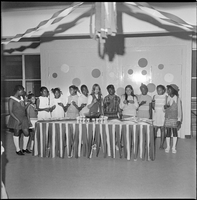Search the Special Collections and Archives Portal
Search Results
Andre King oral history interview
Identifier
Abstract
Oral history interview with Andre "Brother Dre" King conducted by Claytee D. White on July 20, 2018 for the Remembering 1 October Oral History Project. In this interview, King recalls learning judo and wrestling at an early age. After spending ten years in prison for a burglary offense, he served an additional eleven years in facilities across the state. After twenty-one years in the system, King is now a nondenominational spiritual being and once he learned about the Healing Garden for 1 October victims, he went there daily, during and immediately after the construction. King has helped many survivors and has healed himself as well, through giving love, hugs, and spiritual inspiration.
Archival Collection
Marie Wakefield oral history interview
Identifier
Abstract
Oral history interview with Marie Wakefield conducted by Ashley Hardison on November 30, 2008 for the Public School Principalship Oral History Project. In this interview, Wakefield reflects upon her career as an administrator with Nevada’s Clark County School District. She describes her experience as principal of Myrtle Tate Elementary School, her regular job responsibilities, and challenges that she faced. She also describes her experience as an African American woman, and the importance of student and faculty diversity within schools.
Archival Collection


Gladys Boggs Marshall Papers
Identifier
Abstract
The Gladys Boggs Marshall Papers consist of various artistic works created by Gladys Boggs Marshall, written from 1907 to 1974. The papers include several of her poems, a manuscript draft of an unfinished paper "History and Story of Las Vegas," a scrapbook of family photographs, sheet music, and newspaper clippings.
Archival Collection
Margaret Riskin oral history interview
Identifier
Abstract
Oral history interview with Margaret Riskin conducted by Anna Huddleston on August 12, 2014 for the West Charleston Neighborhoods: an Oral History Project of Ward 1. In this interview, Riskin discusses living in Las Vegas, Nevada since 1993. She talks about moving into a home in the Scotch 80s neighborhood, her neighbors, and the home owner association for the neighborhood. Riskin describes security concerns in the Scotch 80s, experiencing a home robbery, and why she decided to relocate. Lastly, Riskin discusses community events held in her neighborhood.
Archival Collection
Rita Deanin Abbey oral history interview
Identifier
Abstract
Oral history interview with Rita Deanin Abbey conducted by Claytee White on November 29, 2014 for the Boyer Early Las Vegas Oral History Project. The artist and UNLV Emeritus Professor of Art discusses her early education and training in art that led her to work in sculpture, painting, stained glass, and other mediums. She also talks about her pieces created for the Jewish community in Las Vegas, Nevada.
Archival Collection
Richard and Gertrude Rudiak with Dani Ramage oral history interview
Identifier
Abstract
Oral history interview with Richard and Gertrude Rudiak with Dani Ramage conducted by Barbara Tabach on December 30, 2015 for the Southern Nevada Jewish Heritage Project. Richard talks about his father, who was an early Nevada Assemblyman and a civil rights activist. Gertrude discusses her hobby of playing the pipe organ, teaching in both secular and Jewish education, and being on many community boards.
Archival Collection
Sharon Maurer-Schwartz oral history interview
Identifier
Abstract
Oral history interview with Sharon Maurer-Schwartz conducted by Barbara Tabach on February 01, 2016 for the Southern Nevada Jewish Heritage Project. Maurer-Schwartz, with her wife Edna Rice, talks about being part of the gay/Jewish life together over the years including in Las Vegas, Nevada. Both women discuss why they moved to Nevada and the early days of The Center, an LGBT center, which hosted a Passover Seder.
Archival Collection
Pacific Engineering and Production Company of Nevada (PEPCON) Disaster Collection of News Articles
Identifier
Abstract
The Pacific Engineering and Production Company of Nevada (PEPCON) Disaster Collection of News Articles (1988-1992) consists of articles from Las Vegas and other state and regional newspapers about the PEPCON plant explosion that took place in May of 1988. Also included are United Press International press releases from October to December, 1988.
Archival Collection
